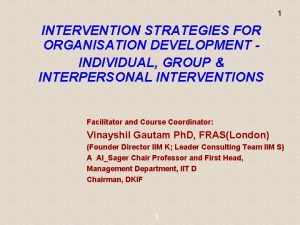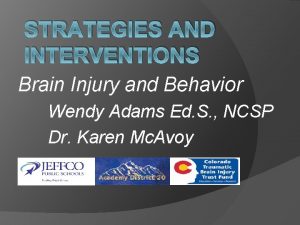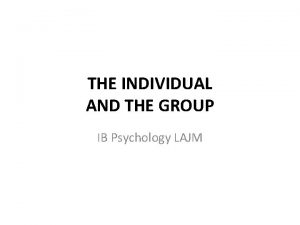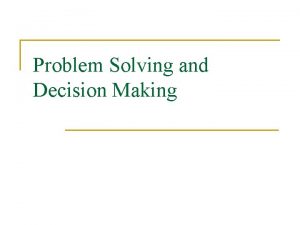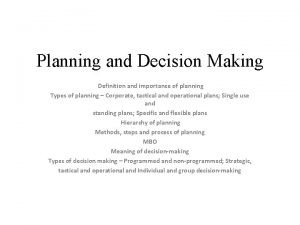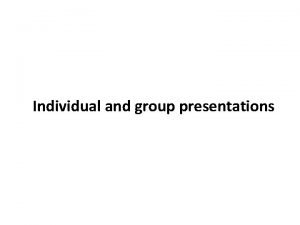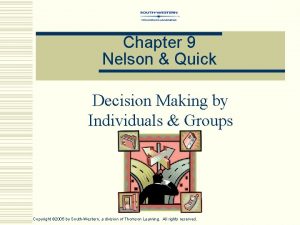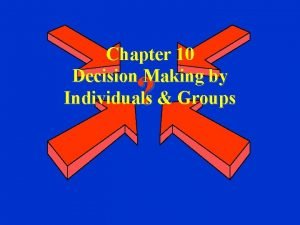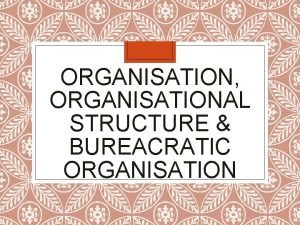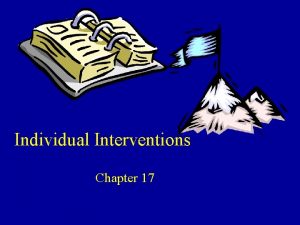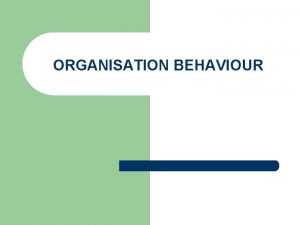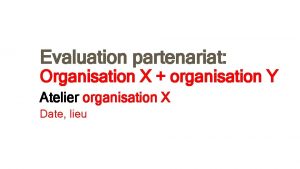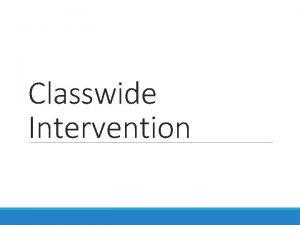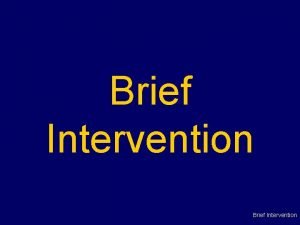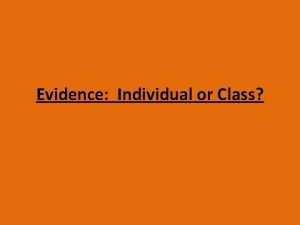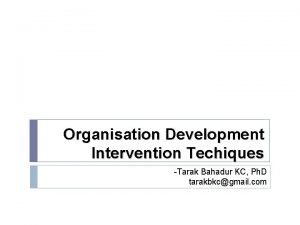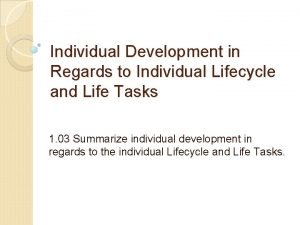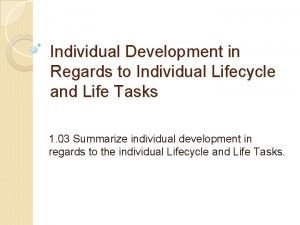1 INTERVENTION STRATEGIES FOR ORGANISATION DEVELOPMENT INDIVIDUAL GROUP






































- Slides: 38

1 INTERVENTION STRATEGIES FOR ORGANISATION DEVELOPMENT INDIVIDUAL, GROUP & INTERPERSONAL INTERVENTIONS Facilitator and Course Coordinator: Vinayshil Gautam Ph. D, FRAS(London) (Founder Director IIM K; Leader Consulting Team IIM S) A Al_Sager Chair Professor and First Head, Management Department, IIT D Chairman, DKIF 1

INTERVENTIONS 2 WHEN INTERVENTIONS ARE REQUIRED? Technology assessment and diversification Continual changes Organization failing to perform well for a long time Change in top management team Attrition of key persons In a nut shell interventions are required when some goals are not being met and when there are some unwanted symptoms. 2

INTERVENTIONS – Specific activities that result from the process of diagnosis and feedback – Is any event directed towar+ds improving organisational effectiveness that disrupts an organisation’s normal way of operating – It sometimes involve consultant from outside the organisation 3 3

4 INTERVENTIONS § Chris Argyris - “To intervene is to enter into an ongoing system of relationship to come between or among persons, groups or objects for the purpose of helping them” § Requirement for successful interventions (a) Intervenor must have valid and useful informations (b) Free Choice (c) Internal Commitment 4

INTERVENTIONS WHAT INTERVENTIONS IS SUPPOSED TO DO ? § Interventions aims at fulfilling organisational goals relating to the three dimensions of organisational effectiveness a) Task dimensions b) Behavioral dimensions c) Adaptation capabilities 5 5

INTERVENTIONS Attributes that the OD Practitioner introduces into the organisational setting: - § Set of Values § Set of Assumptions § Personal and Organisational Goals § Variety of Structures, Activities and Techniques 6 6

CLASSIFYING INTERVENTIONS 7 BASED ON ORGANISATIONAL UNIT OF ANALYSIS AND SYSTEM VARIABLE o INDIVIDUAL INTERVENTIONS o INTERPERSONAL INTERVENTIONS o GROUP INTERVENTIONS o INTER-GROUP INTERVENTIONS o ORGANISING INTERVENTIONS 7

INTERVENTIONS DISCUSSED HERE o JOHARI WINDOW o MYERS- BRIGGS TYPE INDICATORS o TRANSACATIONAL ANALYSIS o MANAGERIAL GRID o THIRD PARTY INTERVENTION o SURVEY FEEDBACK 8 8

9 INTERVENTIONS DISCUSSED HERE o QUALITY CRICLES o SMALL GROUP ACTIVITY METHOD o SIX SIGMA TASK FORCE 9

JOHARI WINDOW § Designed by Joe Luft and Harry Ingramin 1961. § Addresses evolution of workgroup. § Stresses the criticality of open and honest communication. 10

11 JOHARI WINDOW KNOWN BY OTHERS UNKNOWN BY OTHERS KNOWN BY SELF UNKNOWN BY SELF A B ARENA BLIND C D CLOSED DARK SOURCE: UNDERSTANDING ORGANISATIONAL BEHAVIOUR BY UDAI PAREEK, OXFORD UNIVERSITY PRESS, FIRST ED. 11

12 APPLICATION OF JOHARI WINDOW is used to describe the evolution of a work group. When people first meet, their public area or arena is small and closed areas are large. Over time, however, more and more information moves from the closed area to arena. This tool is often used in Group Relations Workshops designed to help people understand how unconscious material-that is material from Dark area/unknown area-affects their effectiveness on the job.

MBTI 13 § Focus on the personal styles of individual workers § Acc to theory, behavior is affected by the way a person takes in processes & reacts to the information available. § MBTI rates individuals on 8 dimensions 13

14 MBTI SOURCES OF ENERGY: § EXTRAVERSION(E) VS INTRAVERSION(I) COLLECTING INFORMATION: §SENSING(S) VS INTUITING(N) DECISION MAKING: §THINKING(T) VS FEELING(F) UNDERSTANDING THE WORLD: § JUDGING(J) VS PERCEIVING(P) 14

MBTI § MANAGERIAL STYLES ACCORDING TO MBTI. ESTP INTP ESFP INFP ESTJ ESFJ ISTP ENTP ISFP ENFP ISTJ ENTJ INTJ ISFJ ENFJ INFJ 15

16 APPLICATION OF MBTI can be used to determine the fitness of a person for a particular job Holland(1985) proposed a ‘personality-job fit’ theory which makes a case for job specific personality types. Occupational Personality Groups Preferred Mode Types No Mechanics, Operators 1 Realsitic Helping and developing people Teachers, Counselors 2 Physical, requiring strength Social

TRANSACTIONAL ANALYSIS § Seeks to change the organisational culture by increasing people’s awareness of their interpersonal interactions. Four kinds of Analysis 1. Structural analysis 2. Transactional analysis 3. Game analysis 4. Script analysis § 17

TRANSACTIONAL ANALYSIS § Three ego states : Parent, Adult and Child § Complimentary and crossed transactions Person A Person B Parent Adult Child 18

TRANSACTIONAL ANALYSIS § Ulterior transactions : Games people play Psychological positions in organisations I’m OK, You’re OK I’m not OK, You’re OK I’m OK, You’re not OK I’m not OK, You’re not OK § Script analysis 19

GRID ORGANISATION DEVELOPMENT § System-OD intervention focuses on dimensions of managerial effectiveness § Uses a variety of specially designed diagnostic instruments that enable individuals and groups to study their own behaviour and identify areas that need improvement 20

GRID ORGANISATION DEVELOPMENT High Managerial grid / Leadership grid Concern for People 9 8 7 6 5 4 3 1 0 1 2 Low 2 3 4 5 6 7 8 9 Country club Impoverished Middle road Team Task Concern for Results Low High 21

GRID ORGANISATION DEVELOPMENT 22 § Implementing Grid organisation development § Phases 1. The Grid seminar 2. Teamwork development 3. Intergroup development 4. Designing Ideal strategic model 5. Implementing Ideal strategic model 6. Systematic critique

GROUP INTERVENTIONS 23 THIRD PARTY INTERVENTIONS § WHEN TWO GROUPS ARE ENGAGED IN A CONFLICT AND A THIRD PARTY STEPS IN TO FACILITATE A POSITIVE DISCUSSION § THREE BASIC COMPONENTS OF THIRD PARTY INTERVENTION : 1. CONFRONTATION : CONFRONT THE CONFLICT 2. DIAGNOSIS : SUBSTANTIVE AND EMOTIONAL ISSUES 3. RESOLUTION : IDENTIFY THE COMMONALITIES 23

THE CYCLICAL MODEL OF INTERPERSONAL CONFLICT Behaviour Triggering events Issues Consequences Episode 1 Source : Walton, 1987 Consequences Episode 2 24

ELEMENTS OF CYCLE OF CONFLICT AND OBJECTIVES OF CONFLICT DIALOGUE 25 ELEMENTS OF CONFLICT DIAGNOSTIC OBJECTIVES ACTION OBJECTIVES ISSUES IDENTIFY BASIC ISSUES : DIFFERENTIATE BETWEEN RESOLVABLE AND UNRESOLVABLE RESOLVE THROUGH COMPROMISE ON SUBSTANTATIVE ISSUES AND WORKING THROUGH EMOTIONAL ISSUES TRIGGERS IDENTIFY BARRIERS TO CONFLICT AND EVENTS THAT TRIGGER CONFLICT AVOID TRIGGERING NEW EPISODE TACTICS OR RESOLUTION INITIATIVES UNDERSTAND HOW CHARACTERISTIC CONFLICT BEHAVIOURS CAN GENERATE ADDITIONAL ISSUES LIMIT DESTRUCTIVE TACTICS AND ENCOURAGE CONSTRUCTIVE INITIATIVES CONSEQUENCES UNDERSTAND THE FEELINGS GENERATED BY EPISODES OF CONFLICT, HOW THEY ARE COPED WITH, AND WHETHER THEY WILL FUEL ANOTHER EPISODE ASSIST PRINCIPALS TO COPE MORE CONSTRUCTIVELY WITH FEELINGS AND OTHER CONSEQUENCES OF CONFLICT.

26 ORGANISATION-WIDE INTERVENTION SURVEY FEEDBACK PROCESS COMPRISES OF : 1. ORGANISATION MEMBERS COMPLETE QUESTIONNAIRES ON VARIOUS ORGANISATIONAL ISSUES 2. RECEIVE FEEDBACK ON RESULTS 3. TAKE APPROPRIATE ACTION TO ADDRESS CRITICAL NEEDS AND CONCERNS

27 ORGANISATION-WIDE INTERVENTION – SURVEY FEEDBACK IS A FOUR-PHASE PROCESS 1. DEVELOPING A SURVEY INSTRUMENT 2. ADMINISTERING THE SURVEY 3. SUMMARISING AND ANALYSING THE RESULTS 4. FEEDING BACK THE RESULTS AND CREATING ACTION PLANS THE WHOLE PROCESS IS CYCLICAL

SURVEY FEEDBACK IS A FOURPHASE PROCESS Phase I Phase II Survey Development Phase IV Feedback Action Planning Implement action plans Source : Smither, Houston, Mc. Intire Data Collection Phase III Summary Analysis of Results 28

GROUP INTERVENTIONS 29 § What is a Group ? § Importance of work groups & team in bringing about organisational change. § Group Interventions are frequently directed toward process by which decisions are made. Group Interventions Techniques Quality Circle Small Group Activity Six Sigma Task Force §

GROUP INTERVENTIONS 30 QUALITY CIRCLE ( QC ) § Small groups of employees that meet regularly to discuss solutions to problems that arise in the workplace. § Supervisor Nominated to coordinate the meeting. Problems are identified by Brainstorming. Problems are prioritized. Information is collected & ideas are generated. Solution is put forwarded to the management. § §

GROUP INTERVENTIONS Problem Solving by QC § Primary Activity : Problem Solving § Brainstorming § Nature of the Problem: To analyze the problem, Seven Quality Control Tools are used. § Factors contributing to the problem 31

GROUP INTERVENTIONS 32 SMALL GROUP ACTIVITY METHOD Why a Non-Lecture Approach? § We learn by doing. § Basic Structure Small Group Tasks : The idea is to work together, not to compete. Report-Back : Report back to the workshop as a whole how his or her group tackled the particular problem. Summary : The trainer highlights the key points. §

GROUP INTERVENTIONS 33 Three Basic Learning Exchanges Worker to Worker : It allowing people to learn from each other by solving problems in their small groups. Worker to Trainer : SGAM allows us to listen to those we are training, we get to learn more and more about the realities people face. Trainer to Worker : This is the traditional learning procedure of school.

GROUP INTERVENTIONS 34 SIX SIGMA TASK FORCE What is Six Sigma ? The Six Sigma Methodologies are a business philosophy & initiative that enable world class quality & continuous improvements to achieve the highest level of customer satisfaction. § Six Sigma is the new standard of excellence at only 3. 4 DPMO. § Six Sigma philosophy uses data & statistical tools to systematically improve processes & sustain process improvements. §

GROUP INTERVENTIONS 35 Six Sigma is a Project Focused approach consisting of Five Phases. DEFINE : Customer needs are stated & processes & products to be improved are identified. MEASURE : Determines the target & baseline performance, defines the I / O variables & validates the measurement systems. ANALYZE : Use data to establish the key process inputs that affect process outputs. IMPROVE : Identify improvements to optimize Output & reduce defects. CONTROL : Documents, monitors & assigns the accountability for sustaining the gains made by process improvements.

GROUP INTERVENTIONS 36 § In six sigma functional organisation is divided into project task forces. § More Focus on specific tasks. § Constructive Inter group dynamics. § Payoffs being shared by team members.

REFERENCES 37 § Organization Theory and Behaviour – V S P Rao & P S Narayana, Vikas Publishing House Pvt. Ltd, 1986 § Business Psychology and Organisational Behaviour – Eugene Mc. Kenna, Vikas Publishing House Pvt. Ltd, 2002 § Organisational Theory and Behaviour – R. A. Sharma, Tata Mc. Graw-Hill Publishing Co. Ltd. , 1985 § Organisational Development – Robert D. Smither, John M. Houston, Sandra D. Mclntire, Haper Collins College Publishers, 1996

38 THANK YOU
 Group intervention strategies
Group intervention strategies Tbi intervention strategies
Tbi intervention strategies Grid od intervention
Grid od intervention Culturally appropriate intervention strategies
Culturally appropriate intervention strategies Group level intervention
Group level intervention Rdi relationship development intervention program
Rdi relationship development intervention program Stereotypes ib psychology
Stereotypes ib psychology Individual and group decision making
Individual and group decision making Nature of decision making
Nature of decision making Individual and group decision making
Individual and group decision making Difference between individual and group presentation
Difference between individual and group presentation Horizontal solutions group synergy
Horizontal solutions group synergy Individual and group decision making
Individual and group decision making Individual and group behaviour
Individual and group behaviour Www managementstudyguide com
Www managementstudyguide com Objective of group discussion
Objective of group discussion Digital strategies group
Digital strategies group Formuö
Formuö Typiska drag för en novell
Typiska drag för en novell Nationell inriktning för artificiell intelligens
Nationell inriktning för artificiell intelligens Vad står k.r.å.k.a.n för
Vad står k.r.å.k.a.n för Varför kallas perioden 1918-1939 för mellankrigstiden
Varför kallas perioden 1918-1939 för mellankrigstiden En lathund för arbete med kontinuitetshantering
En lathund för arbete med kontinuitetshantering Kassaregister ideell förening
Kassaregister ideell förening Personlig tidbok
Personlig tidbok Anatomi organ reproduksi
Anatomi organ reproduksi Förklara densitet för barn
Förklara densitet för barn Datorkunskap för nybörjare
Datorkunskap för nybörjare Boverket ka
Boverket ka Debattartikel mall
Debattartikel mall Delegerande ledarstil
Delegerande ledarstil Nyckelkompetenser för livslångt lärande
Nyckelkompetenser för livslångt lärande Påbyggnader för flakfordon
Påbyggnader för flakfordon Kraft per area
Kraft per area Offentlig förvaltning
Offentlig förvaltning Lyckans minut erik lindorm analys
Lyckans minut erik lindorm analys Presentera för publik crossboss
Presentera för publik crossboss Argument för teckenspråk som minoritetsspråk
Argument för teckenspråk som minoritetsspråk Kanaans land
Kanaans land
